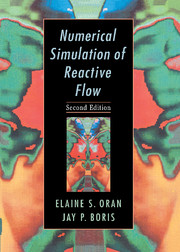Book contents
- Frontmatter
- Contents
- Prologue
- 1 An Overview of Numerical Simulation
- 2 The Reactive-Flow Modeling Problem
- 3 Models and Simulation
- 4 Some General Numerical Considerations
- 5 Ordinary Differential Equations: Reaction Mechanisms and Other Local Phenomena
- 6 Representations, Resolution, and Grids
- 7 Diffusive Transport Processes
- 8 Computational Fluid Dynamics: Continuity Equations
- 9 Computational Fluid Dynamics: Using More Flow Physics
- 10 Boundaries, Interfaces, and Implicit Algorithms
- 11 Coupling Models of Reactive-Flow Processes
- 12 Turbulent Reactive Flows
- 13 Radiation Transport and Reactive Flows
- Index
6 - Representations, Resolution, and Grids
Published online by Cambridge University Press: 09 October 2009
- Frontmatter
- Contents
- Prologue
- 1 An Overview of Numerical Simulation
- 2 The Reactive-Flow Modeling Problem
- 3 Models and Simulation
- 4 Some General Numerical Considerations
- 5 Ordinary Differential Equations: Reaction Mechanisms and Other Local Phenomena
- 6 Representations, Resolution, and Grids
- 7 Diffusive Transport Processes
- 8 Computational Fluid Dynamics: Continuity Equations
- 9 Computational Fluid Dynamics: Using More Flow Physics
- 10 Boundaries, Interfaces, and Implicit Algorithms
- 11 Coupling Models of Reactive-Flow Processes
- 12 Turbulent Reactive Flows
- 13 Radiation Transport and Reactive Flows
- Index
Summary
This chapter returns to the problems of representing a continuous physical variable by a discrete set of numbers, and then using this representation as a basis for solving the equations of the mathematical model. Here the term computational representation includes:
the particular discretization (that is, the mesh, grid, or expansion) used to approximate the continuous flow variables,
the data structures used to present this discretization to the computer, and
the interpretation procedure used to reconstruct a numerical approximation of the continuous variable from the set of discrete quantities.
Choosing a computational representation is just as important as choosing a mathematical model to describe the system, or choosing the algorithms to implement that model. For example, the choice of either an Eulerian or Lagrangian representation is important because this choice constrains the type of numerical algorithms and gridding methods that can be used.
This chapter describes the basic concepts underpinning different approaches to finding a good computational grid. This topic has received a great deal of attention in the computational fluid dynamics community, and has been the subject of many conferences and reviews. It is extremely important for solving practical problems in realistic geometries or where complex flow patterns develop. Part of the problem is generating the initial grid, another part is modifying it appropriately as the flow or computational domain evolves. Localized improvements in resolution can substantially increase accuracy at relatively little computational cost.
The material covered in this chapter is complicated and covers information from many areas of research in a cursory manner. In fact, each section or even subsection deserves at least an extensive review article.
- Type
- Chapter
- Information
- Numerical Simulation of Reactive Flow , pp. 159 - 203Publisher: Cambridge University PressPrint publication year: 2000



